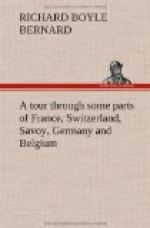At the village of St. Blaise we observed, under the sign of one of the inns, the sentiment, “Honorez le Roi; soignez l’agriculture” We next proceeded to visit the celebrated lake of Bienne, which is about nine English miles by four. The isle of St. Pierre, so much praised by Rousseau, is situated near the centre of the lake, about a league from Cerlier, where we embarked for it. It is about half a league in circumference. The ancient convent is inhabited by a farmer, and the bed of the philosophic Rousseau is now at the command of any of his admirers who may wish to repose in it.
There is also a large building, which is in summer the scene of much festivity, and which commands an extensive and interesting prospect.
One side of this island rises boldly from the lake to a great height; the other is on a level with its waters. It contains many vineyards, and several large chesnut trees. The town of Bienne, until its union to France in 1799, presented the singularity of a Protestant state being nominally subject to a Roman Catholic prelate (the Bishop of Basle). Its liberties were guaranteed by the Swiss Diet, where it sent a representative, a privilege the bishop did not possess. Its future government is not yet determined on. The country about Nydau more resembles Holland and Switzerland, being marshy, or drained by Canals. Many Swiss writers are of opinion, that formerly the lakes of Neufchatel, Morat and Bienne were united; and the appearance of the country renders the supposition not improbable.
The Pont de Thiel divides the territories of Rome and Neufchatel; and it is also the limit of the French language, none of the peasants beyond the bridge being able to answer any questions but in German. However, at all the chief inns, in both Switzerland and Germany, some of the waiters speak French. It is difficult to suppose a more sudden change than presents itself to the traveller on his passing this bridge. The houses, dress, and appearance of the inhabitants, all announce that he is arrived in a country differing entirely from France, Savoy, and the Pays de Vaud.
The enormous black crape head-dresses of the women have a most singular effect, as well as their long hair, which reaches halfway down their backs, plaited into several divisions. It is said, that in some districts, the females after marriage, roll it round their heads. The costume of the men much resembles that of our sailors. Cotton or woollen caps are more worn than hats, as was the custom in England until about the time of Henry the Eighth.




